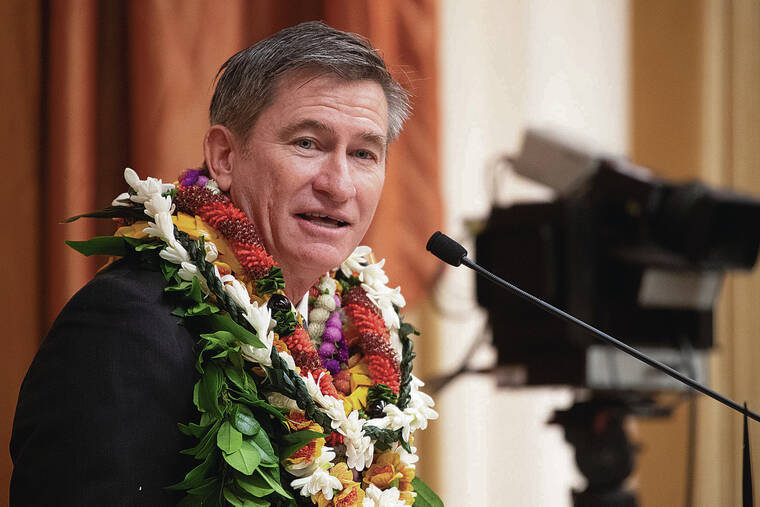The Honolulu City Council on Wednesday unanimously passed a $3.22 billion executive operating budget Opens in a new tab and a $1.03 billion capital improvement plan Opens in a new tab for the fiscal year that begins July 1.
The Council voted in favor of an operating budget that is about $100 million less than what Mayor Rick Blangiardi proposed and a CIP that is about $228 million more.
The operating budget grew this year by about $300 million due to an increase in city revenue from property taxes and a new county hotel tax. There was about a 9% increase in real property valuations, and a new 3% transient accommodations tax was implemented in December. The city expects the new hotel tax will bring in about $86 million, with about $50 million going to the general fund.
The rest of the TAT revenue is to be split between the rail project and a special fund for natural resources.
Main changes to Blangiardi’s proposed operating budget are more funding for the Department of Emergency Services Ocean Safety Division, maintenance services in the Department of Parks and Recreation and the Department of Customer Services.
The Department of Parks and Recreation will see an overall increase in funding from last year of about $5.2 million. And the Department of Customer Services will see an increase of $417,010 from last year’s budget. That was due to amendments from the Council, where in Blangiardi’s proposed budget the department would have seen an overall decrease.
Emergency Services will still see an overall decrease in funding from last year of about $3.17 million although the Council did restore about $350,500 to the Ocean Safety Division from Blangiardi’s proposed budget.
Of the first responders, the Honolulu Police Department received the largest increase in funding this year of $12.6 million.
The city department that saw the largest increase this year was the Department of Transportation Services at about $61.7 million.
One of the more controversial items that was included in the Department of Design and Construction’s budget this year was $1.3 million to remove the Haiku Stairs. The city included $1 million in the CIP last year, but this year added on $300,000 due to an increase in the cost of goods.
Blangiardi reaffirmed his position Wednesday that he would proceed with the removal of the Haiku Stairs. It is expected to begin later this year, according to a city spokesperson.
“It’s fascinating that it encompasses all services that the general public at large is receiving,” he said.
“We have to … try our best to fill the 3,000-plus vacancies that we have in the county of Oahu, which is about 27% of our workforce … This budget is not my budget, but it is the members of the Council’s budget along with the administration.”
The CIP mainly focuses on updating the city’s sewage and water treatment systems, although there is about $16.37 million dedicated to expanding affordable housing.
“This budget reflects the needs of our community as so many struggle to live in our island home,” said Council Chair Tommy Waters in an emailed statement.
“From funding affordable housing to fighting for clean water, the Council stands strong in our commitment toward supporting an equitable recovery from the COVID-19 pandemic. I am hopeful that this budget will help us to see greater City services to ensure the health and safety of our ‘aina and neighborhoods.”
The Council also included about $167 million for projects that it wanted funded through federal America Rescue Plan Funds in the CIP.
The federal government awarded states and municipalities millions of dollars of relief funds meant to offset the public health and economic impact of the COVID-19 pandemic. Honolulu was awarded $386 million to be received in two installments.
The city administration largely took control of the first $193 million of the federal funds distributed last June, but the Council was able to appropriate the second $193 million, which is expected to come this summer.
The Council’s projects focus on housing, economic revitalization and infrastructure improvement. Cost estimates were listed for each project, but it will be up to the administration to decide the final amounts needed.
About $62.8 million of the ARPA funds allocated by the Council will be going toward affordable housing programs. The most costly ARPA program is $25 million for the Honolulu Board of Water Supply to protect the island’s water resources following the aquifer contamination from the Navy’s Red Hill Bulk Fuel Storage Facility.
“It’s quite historical because a lot of things that we want, as well as the administration wants, it’s very difficult when you’re dealing with it only within the context of the annual budget,” Council member Esther Kia‘aina said. “Hopefully, with the second tranche of funds, we can do a lot of good things for the people.”
Kia‘aina represents the Council on the administration’s nine-person committee that vets ARPA projects to make sure they comply with federal guidelines.
The budget will go to the mayor for his signature. Blangiardi said he will be signing both the CIP and the operating budget.
The Council also approved the rail recovery plan in a 6-3 vote. The plan notably shortens the route to end at the Civic Center in Kakaako rather than continuing on to Ala Moana Center. It also delays the construction of the Pearl Highlands parking garage.
Council members Heidi Tsuneyoshi, Carol Fukunaga and Augie Tulba voted against the plan.
The recovery plan is an effort to obtain $744 million from the Federal Transit Administration which it is withholding due to cost overruns. The FTA has given the Honolulu Authority for Rapid Transportation until June 30 to establish an acceptable recovery plan before distributing the funds.
With the Council’s favorable vote, HART will now take the plan to the FTA for approval.

